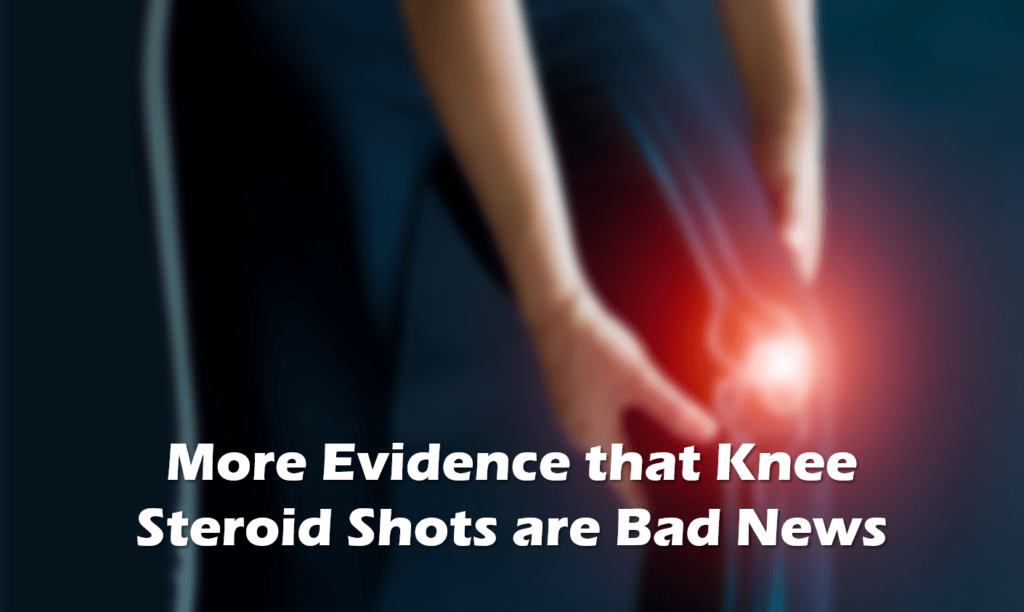More Research that Steroid Shots for Knee Arthritis Are Bad News

There has been a slew of studies these past few years showing that injecting a knee with steroids is a really bad idea. However, this continues to be the number one injection-based therapy offered to patients with knee arthritis. Now a new study adds more fuel to the idea that these shots are causing way more harm than good.
Steroid Shots
While you may think of anabolic steroids used by bodybuilders when you hear this term, the most common form given to patients is the anti-inflammatory cousin called “corticosteroids”. These are powerful medications that can reduce swelling,. The most common term used is “cortisone”. This is by far the most used knee injection in the world to treat knee pain caused by arthritis.
Cartilage is that stuff on the ends of bones that absorbs shock for the joint. When you have arthritis, the cartilage progressively wears away eventually causing “bone on bone”. So any drug used to treat arthritis that kills cartilage cells is a problem.
We’ve known for a very LONG time that steroid shots are bad for cartilage. In fact, the first research on the effect of steroid shots on cartilage was in 1951! (2) That research was followed by many other publications in the 1960s and then many animal studies showing that steroid shots kill off cartilage cells in joints (3,4). More recently, high-quality research demonstrated that the injection doesn’t work to help knee pain as well as once thought and destroys normal cartilage (1).
Nasty Side Effects with Joint Replacements
Most patients have a hard time grasping (as do physicians) that a simple steroid shot in a joint can increase the risk for a serious joint infection if the patient needs a later joint replacement. In addition, it’s equally hard to grasp that this injection could possibly make you more likely to require a joint replacement if you have arthritis.
Based on published research, we’ve known for years that patients who get steroid shots are at higher risk for infection if they get a joint replacement down the road (5). This effect is not only seen in knee joints but also in hips (6). In addition, research also shows that getting a steroid shot to help the pain from knee arthritis can increase your chances of needing a knee replacement (7). Hence, a steroid shot in your arthritic joint not only increases your risk for a joint replacement infection but also increases your risk for needing one in the first place.
The New Research
Researchers at the Hospital for Special Surgery and Cornell performed an analysis of an insurance database looking at patients who had knee and hip steroid shots before they had their joints replaced (8). Knee replacement patients who had a single steroid shot in the year before their joint replacement had had lower odds that they would need to use narcotics after their procedure. However, patients who had two or more steroid injections needed to use narcotics for knee pain more often despite their knee replacement. Patients who used 2 or more hyaluronic acid (knee gel shots) fared better on narcotic use.
The upshot? Steroid injections to treat pain associated with knee arthritis continue to be shown to be bad news. Hence, “Just Say NO” if your doctor wants to inject you with this toxic medication.
_____________________________
References:
(1) (1) McAlindon TE, LaValley MP, Harvey WF, et al. Effect of Intra-articular Triamcinolone vs Saline on Knee Cartilage Volume and Pain in Patients With Knee Osteoarthritis: A Randomized Clinical Trial. JAMA.2017;317(19):1967–1975. doi: 10.1001/jama.2017.5283
(2) STEINBROCKER O, EHRLICH ME, SILVER M, SICHER W, BERKOWITZ S, CARP S, FEISTEIN H. The clinical application of cortisone and ACTH in arthritis and related conditions: methods and problems. II: Side effects complications, contraindications, precautions and conclusions. Ariz Med. 1951 Sep;8(9):29-35.
(3) Wang BL, Sun W, Shi ZC, et al. Decreased proliferation of mesenchymal stem cells in corticosteroid-induced osteonecrosis of femoral head. Orthopedics. 2008;31(5):444. doi:10.3928/01477447-20080501-33
(4) Murray RC, DeBowes RM, Gaughan EM, Zhu CF, Athanasiou KA. The effects of intra-articular methylprednisolone and exercise on the mechanical properties of articular cartilage in the horse. Osteoarthritis Cartilage. 1998;6(2):106‐114. doi:10.1053/joca.1997.0100
(5) Richardson SS, Schairer WW, Sculco TP, Sculco PK. Comparison of Infection Risk with Corticosteroid or Hyaluronic Acid Injection Prior to Total Knee Arthroplasty. J Bone Joint Surg Am. 2019 Jan 16;101(2):112-118. doi: 10.2106/JBJS.18.00454.
(6) Ravi B, Escott BG, Wasserstein D, Croxford R, Hollands S, Paterson JM, Kreder HJ, Hawker GA. Intraarticular hip injection and early revision surgery following total hip arthroplasty: a retrospective cohort study. Arthritis Rheumatol. 2015 Jan;67(1):162-8. doi: 10.1002/art.38886.
(7) Wijn SRW, Rovers MM, van Tienen TG, Hannink G. Intra-articular corticosteroid injections increase the risk of requiring knee arthroplasty. Bone Joint J. 2020 May;102-B(5):586-592. doi: 10.1302/0301-620X.
(8) Wilson LA, Liu J, Fiasconaro M, Poeran J, Nwachukwu BU, Memtsoudis SG. Increased Use of Intra-Articular Steroid Injection to Treat Osteoarthritis is Associated With Chronic Opioid Dependence After Later Total Knee Arthroplasty But Not Total Hip Arthroplasty [published online ahead of print, 2020 Apr 11]. J Arthroplasty. 2020;S0883-5403(20)30342-9. doi:10.1016/j.arth.2020.04.012

If you have questions or comments about this blog post, please email us at [email protected]
NOTE: This blog post provides general information to help the reader better understand regenerative medicine, musculoskeletal health, and related subjects. All content provided in this blog, website, or any linked materials, including text, graphics, images, patient profiles, outcomes, and information, are not intended and should not be considered or used as a substitute for medical advice, diagnosis, or treatment. Please always consult with a professional and certified healthcare provider to discuss if a treatment is right for you.
